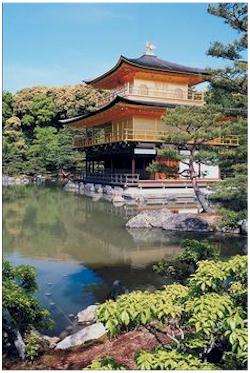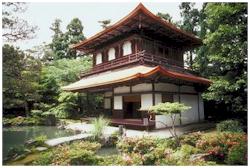 DISCOVER KYOTO
DISCOVER KYOTO
Kyoto is a city in the central part of the island of Honshu, Japan. It has a population close to 1.5 million. Formerly the imperial capital of Japan, it is now the capital of Kyoto Prefecture, as well as a major part of the Osaka-Kobe-Kyoto metropolitan area.
 Tourism forms a large base of Kyoto's economy. The city's cultural heritages are constantly visited by school groups from across Japan, and many foreign tourists also stop in Kyoto. The city's tourism has been setting new records for domestic tourism 6 times straight, and it was in 2007 chosen the 2nd most beautiful city in Japan, in a regional brand survey.
Tourism forms a large base of Kyoto's economy. The city's cultural heritages are constantly visited by school groups from across Japan, and many foreign tourists also stop in Kyoto. The city's tourism has been setting new records for domestic tourism 6 times straight, and it was in 2007 chosen the 2nd most beautiful city in Japan, in a regional brand survey.
 CULTURE OF KYOTO CULTURE OF KYOTO
Although ravaged by wars, fires, and earthquakes during its eleven centuries as the imperial capital, Kyoto was spared from the firebombing of World War II.
With its 2000 Buddhist temples and Shinto shrines, as well as palaces, gardens and architecture intact, it is one of the best preserved cities in Japan.
Among the most famous temples in Japan are Kiyomizu-dera, a magnificent wooden temple supported by pillars off the slope of a mountain; Kinkaku-ji, the Temple of the Golden Pavilion; and Ginkaku-ji, the Temple of the Silver Pavilion; and Ryoan-ji, famous for its rock garden.
The Heian Jingu is a Shinto shrine celebrating the Imperial family (built in 1895) and commemorating the first and last emperors to reside in Kyoto. Three special sites have connections to the imperial family: Kyoto Imperial Palace and Sento Imperial Palace, homes of the Emperors of Japan for many centuries; Katsura Imperial Villa, one of the nation's finest architectural treasures; and Shugaku-in Imperial Villa, one of its best Japanese gardens.
Other notable sites in and around Kyoto include Arashiyama and its picturesque lake, the Gion and Pontocho geisha quarters, the Philosopher's Walk, and the canals which line some of the older streets.
The "Historic Monuments of Ancient Kyoto" are listed by the UNESCO as a World Heritage Site. These include the Kamo Shrines (Kami and Shimo), Kyo-o-Gokokuji (To-ji), Kiyomizu-dera, Daigo-ji, Ninna-ji, Saiho-ji (Kokedera), Tenryu-ji, Rokuon-ji (Kinkaku-ji), Jisho-ji (Ginkaku-ji), Ryoan-ji, Hongan-ji, Kozan-ji and the Nijo Castle, primarily built by the Tokugawa shoguns. Other sites outside the city are also on the list.
Kyoto is renowned for its abundance of delicious Japanese foods and cuisine. The special circumstances of Kyoto as a city away from the sea and home to many Buddhist temples resulted in the development of a variety of vegetables peculiar to the Kyoto area.
Japan's television and film industry has its center in Kyoto. Many jidaigeki, action films featuring samurai, were shot at Toei Uzumasa Eigamura. A film set and theme park in one, Eigamura features replicas of traditional Japanese buildings which are used for jidaigeki. Among the sets are a replica of the old Nihonbashi (the bridge at the entry to Edo), a traditional courthouse, a Meiji Period police box and part of the former Yoshiwara red-light district. Actual film shooting takes place occasionally, and visitors are welcome to observe the action. The Kyoto International Manga Museum is also situated in Kyoto where for an entrance fee you are able to view exhibitions and read as much manga as you desire it is trying to get hold of every manga ever published and so far houses approximately 200,000 titles.
 FESTIVALS OF KYOTO FESTIVALS OF KYOTO
Major festivals punctuate Kyoto's calendar. The first is the Aoi Matsuri on May 15. Two months later (July 14 to 17) is the Gion Matsuri, culminating in a massive parade. Kyoto marks the Bon Festival with the Gozan Okuribi, lighting fires on mountains to guide the spirits home (August 16). The October 22 Jidai Matsuri, Festival of the Ages, celebrates Kyoto's illustrious past.
 GEOGRAPHY OF KYOTO GEOGRAPHY OF KYOTO
Kyoto was located in a valley, part of the Yamashiro (or Kyoto) Basin, in the eastern part of the mountainous region known as the Tamba highlands. The Yamashiro Basin is surrounded on three sides by mountains known as Higashiyama, Kitayama and Nishiyama, with a height just under 1000 meters above sea level. This interior positioning results in hot summers and cold winters. There are three rivers in the basin, the Ujigawa to the south, the Katsuragawa to the west, and the Kamogawa to the east. Kyoto City takes up 17.9% of the land in the prefecture with an area of 827.9 km2.
The original city was arranged in accordance with traditional Chinese geomancy following the model of the ancient Chinese capital of Chang'an (present-day Xian). The Imperial Palace faced south, resulting in Ukyo (the right sector of the capital) being on the west while Sakyo (the left sector) is on the east. The streets in the modern-day wards of Nakagyo, Shimogyo, and Kamigyo still follow a grid pattern.
Today, the main business district is located to the south of the old Imperial Palace, with the less-populated northern area retaining a far greener feel. Surrounding areas do not follow the same grid pattern as the center of the city, though streets throughout Kyoto share the distinction of having names.
Kyoto sits atop a large natural water table that provides the city with ample freshwater wells. Due to large scale urbanization, the amount of rain draining into the table is dwindling and wells across the area are drying at an increasing rate.
 ECONOMY OF KYOTO ECONOMY OF KYOTO
Tourism forms a large base of Kyoto's economy. The city's cultural heritages are constantly visited by school groups from across Japan, and many foreign tourists also stop in Kyoto. The city's tourism has been setting new records for domestic tourism 6 times straight, and it was recently chosen the 2nd most beautiful city in Japan, in a regional brand survey.
The city's industry is mainly comprised of small plants, most of which are run by artisans who produce traditional Japanese crafts. Kyoto's kimono weavers are particularly renowned, and the city remains the premier center of kimono manufacturing. Such businesses, vibrant in past centuries, have declined in recent years as sales of traditional goods stagnate.
Kyoto's only sizable heavy industry is electronics: the city is home to the headquarters of Nintendo, OMRON, Kyocera, and Murata Machinery.
 SPORTS IN KYOTO SPORTS IN KYOTO
In football (soccer), Kyoto is represented by Kyoto Purple Sanga who rose to J. League's Division 1 in 2005. With the popularity of the nearby Hanshin Tigers, Kyoto has never had a team in Nippon Professional Baseball, though the Tigers play several neutral-site games at Kyoto's Nishi Kyogoku stadium every year.
Additionally, Kyoto's high school baseball teams are strong, with Heian and Toba in particular making strong showings recently at the annual tournament held in Koshien Stadium, Nishinomiya, near Osaka.
 COLLEGES AND UNIVERSITIES IN KYOTO COLLEGES AND UNIVERSITIES IN KYOTO
Home to thirty-seven institutions of higher education, Kyoto is one of the academic centers of the country. The three largest and best-known local universities are Doshisha, Kyoto, and Ritsumeikan Universities. Among them, Kyoto University is considered to be one of the top universities in Japan, with several Nobel laureates, for example Yukawa Hideki. The Kyoto Institute of Technology is also among the most famous universities in Japan, and is considered to be one of the best universities for architecture and design in the country.
Kyoto also has a unique higher education network called the Consortium of Universities in Kyoto, which consists of three national, five public (prefectural and municipal), and 41 private universities, as well as the city and four other organizations. The consortium does not offer a degree, but offers the courses as part of a degree at participating universities.
As well as more than 30 Japanese universities and colleges, American universities also find the city as an important city of education and research. Kyoto Consortium for Japanese Studies (KCJS) is a consortium of 14 American universities that sponsors a rigorous, two-semester academic program for undergraduates who wish to do advanced work in Japanese language and cultural studies. The program office is based at Kyodai Kaikan, a facility affiliated with Kyoto University. Stanford University has its own Japan Center in Kyoto.
 KYOTO TRANSPORTATION KYOTO TRANSPORTATION
Kyoto Station is the center for transportation in the city. The second-largest in Japan, it houses a shopping mall, hotel, movie theater, Isetan department store, and several local government facilities under one fifteen-story roof. The Tokaido Shinkansen Lineas well as all local rail lines connect here.
Kyoto's municipal bus network and subway system are extensive. Private carriers also operate within the city. Many tourists join commuters on the public buses, or take taxis or tour buses. Buses operating on routes within the city, the region, and the nation stop at Kyoto Station. Kyoto's buses have announcements in English and electronic signs with stops written in the Latin alphabet.
Most city buses have a fixed fare, but a one-day bus pass and a combined unlimited train and bus pass are also available. These are especially useful for visiting many different points of interest within Kyoto. The bus information center just outside the central station handles tickets and passes. The municipal transport company publishes a very useful leaflet called "Bus Navi." It contains a route map for the bus lines to most sights and fare information. This too is available at the information center in front of the main station.
The Tokaido Shinkansen provides passenger rail service linking Kyoto with Nagoya and Tokyo (in one direction) and with nearby Osaka and points west (in the other direction). The trip from Tokyo takes just over two hours. Another way to access Kyoto is via Kansai International Airport. The Haruka Express carries passengers from the airport to Kyoto Station in 72 minutes. There is also frequent service on JR, Keihan Railway, Hankyu Railway, Kintetsu, and other lines to other cities in the Kansai region.
Cycling forms a very important form of personal transportation in the city, to an extent that bicycle culture forms a part of Kyoto's urban identity. The geography and scale of the city are such that the city may be easily navigated on a bicycle.
From Wikipedia
 KYOTO TOURS, TRAVEL & ACTIVITIES KYOTO TOURS, TRAVEL & ACTIVITIES
 KYOTO HOTELS & ACCOMMODATION KYOTO HOTELS & ACCOMMODATION
HOME •
JAPAN •
DISCOVER JAPAN •
Discover Kyoto
|
|
Looking for something specific?
|



Spring for Tea Cermony, Ryoanji, Kyoto, Japan
Photographic Print
Buy at AllPosters.com


Seiryuen Garden, Nijo Castle, Kyoto, Japan
Photographic Print
Buy at AllPosters.com
|







 Tourism forms a large base of Kyoto's economy. The city's cultural heritages are constantly visited by school groups from across Japan, and many foreign tourists also stop in Kyoto. The city's tourism has been setting new records for domestic tourism 6 times straight, and it was in 2007 chosen the 2nd most beautiful city in Japan, in a regional brand survey.
Tourism forms a large base of Kyoto's economy. The city's cultural heritages are constantly visited by school groups from across Japan, and many foreign tourists also stop in Kyoto. The city's tourism has been setting new records for domestic tourism 6 times straight, and it was in 2007 chosen the 2nd most beautiful city in Japan, in a regional brand survey.

